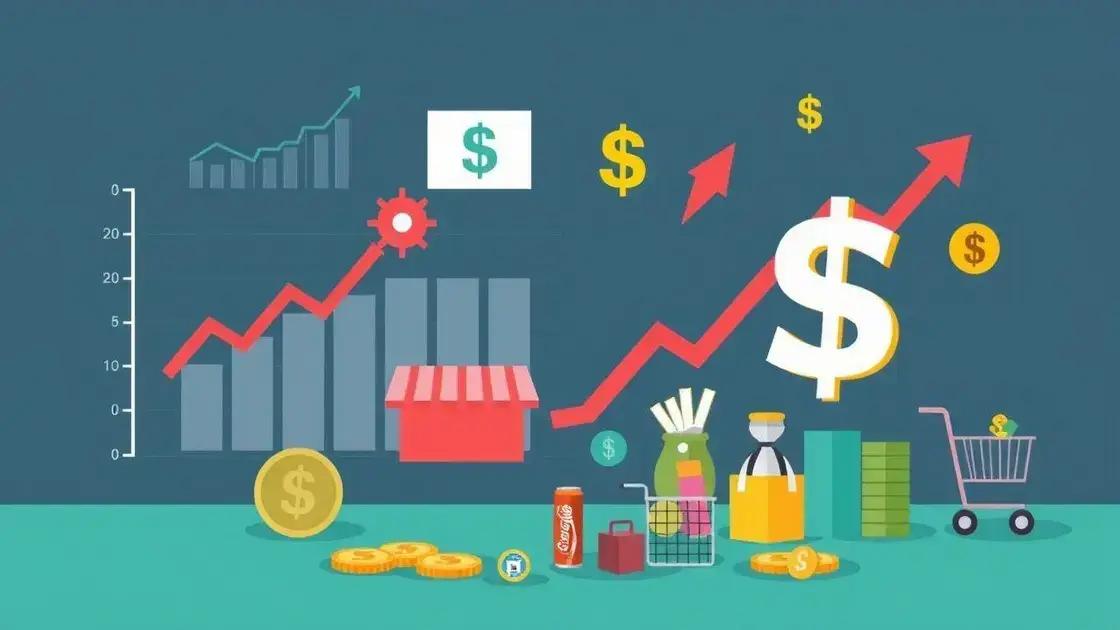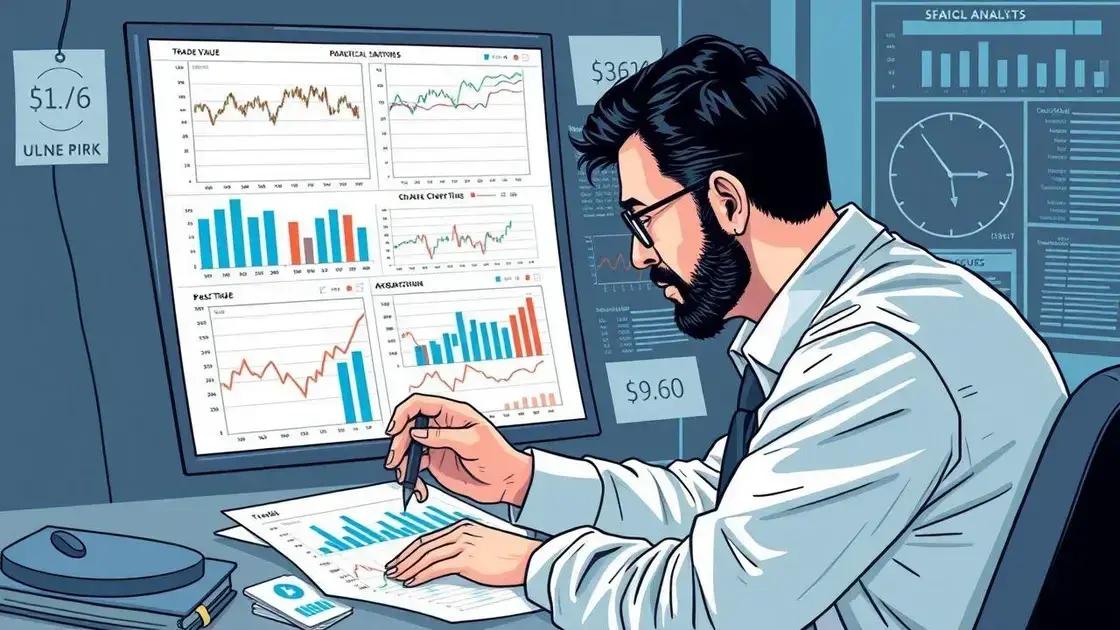Dollar depreciation: what it means for your finances

Anúncios
Dollar depreciation occurs when the value of the U.S. dollar declines against other currencies, impacting consumer prices, trade balances, and overall economic stability.
The concept of dollar depreciation might sound complex, but it plays a crucial role in our daily lives. Have you ever wondered how it affects your shopping habits or your investments? Let’s dive in.
Understanding dollar depreciation
Understanding dollar depreciation is important, especially in today’s changing economic landscape. This concept refers to the decline in value of the U.S. dollar compared to other currencies. When the dollar depreciates, it means that consumers may pay more for imported goods, which can affect their overall purchasing power.
Why does dollar depreciation happen?
Several factors contribute to the depreciation of the dollar. Economic indicators, government policies, and shifts in investor confidence can all play a role. When the economy is not performing well, or when there are high levels of debt, dollar depreciation is more likely to occur.
Main causes of dollar depreciation
- Low interest rates set by the Federal Reserve.
- Increased government debt levels.
- Economic instability or recession.
- Trade deficits with other countries.
Another aspect of dollar depreciation to consider is its impact on international trade. When the dollar loses value, American exports become cheaper for foreign buyers. This can boost sales overseas, helping U.S. companies increase their revenues. However, it also means that imports become more expensive, leading to higher prices for consumers.
Effects on everyday life
The implications of dollar depreciation reach far beyond global markets. For average consumers, this can mean higher prices for goods that rely on imports, such as electronics and clothing. Additionally, travel abroad becomes more costly, as the dollar does not stretch as far.
Investors must also navigate the nuances of dollar depreciation. Currency fluctuations can impact investment returns, especially for those who hold international assets. Therefore, understanding how the dollar’s value shifts is essential for effective financial planning.
Factors leading to currency depreciation
There are many factors leading to currency depreciation. Understanding these can help you navigate the economic landscape better. When a country’s currency loses value, it impacts trade, investments, and even daily life.
Economic indicators
Key economic indicators play a crucial role in determining currency strength. For instance, a high unemployment rate or low GDP growth can signal that the economy is not performing well. Investors often react to these indicators by pulling out of a country, leading to currency depreciation.
Government policies and actions
Government policies can also influence the value of a currency. Decisions made by the Federal Reserve, like lowering interest rates, often lead to a weaker dollar. This happens because lower rates make investing in U.S. assets less attractive compared to other countries. Foreign investors may start selling their dollar-denominated assets, further contributing to depreciation.
- Quantitative easing measures increase the money supply.
- High levels of national debt create uncertainty.
- Trade policies that lead to deficits can weaken the dollar.
Another factor to consider is geopolitical stability. Unrest or uncertainty in a country can drive investors away. When there’s fear about political stability, international investors tend to shift their resources elsewhere, leading to a drop in the currency’s value.
Market sentiment
Market sentiment can be very powerful. If investors believe that the economy is heading towards a downturn, their actions can accelerate currency depreciation. Sometimes, simply the perception of weakness can lead to a self-fulfilling prophecy where the dollar drops just because everyone thinks it will.
Impacts of dollar depreciation on the economy

The impacts of dollar depreciation on the economy can be profound and wide-reaching. When the dollar loses value, it affects everything from consumer prices to international trade dynamics.
Rising costs for consumers
One of the most immediate effects of dollar depreciation is the increase in prices for imported goods. As the dollar weakens, it takes more dollars to purchase foreign products. This can lead to higher prices for everyday items such as electronics, clothing, and food.
Effects on the trade balance
A weaker dollar can also improve a country’s trade balance. When the dollar depreciates, American exports become cheaper for foreign buyers. This can boost demand for U.S. goods, potentially increasing sales and creating jobs. However, as imports become pricier, consumers may shift their purchasing habits towards local products.
- Increased exports can lead to job growth in export-oriented industries.
- Higher import prices can drive some businesses to source domestically.
- Trade deficits may decrease as exports rise.
This adjustment in trade relationships often leads to changes in the economy’s overall health. For instance, while exports may increase, producers of imports may face challenges. Industries that rely heavily on foreign materials might see their costs rise, leading to squeezed profits.
Influence on inflation
Inflation is another significant concern linked to dollar depreciation. As prices rise due to the depreciation, consumers may find their purchasing power diminished. This can create a cycle where higher prices lead to calls for wage increases, which can further fuel inflation.
Additionally, investors may react to a decreasing dollar by shifting their assets. This can create volatility in the financial markets, affecting everything from stocks to bonds. Hence, understanding the impacts of dollar depreciation is crucial for both consumers and businesses navigating these changes.
Strategies to safeguard your finances
Implementing strategies to safeguard your finances becomes essential, especially in uncertain economic times. A depreciating dollar can strain your budget and investment portfolios, but there are ways to protect your hard-earned money.
Diversifying investments
One effective method is to diversify your investments. Instead of putting all your money in one place, consider spreading it across various asset types like stocks, bonds, and commodities. This minimizes risk if one area declines due to dollar depreciation.
Investing in assets that appreciate
Another strategy is to look for assets that typically increase in value during economic downturns. Real estate and precious metals, like gold, can often serve as safe havens when the dollar weakens. These assets not only help preserve wealth but often appreciate over time.
- Monitor currency trends to make informed decisions.
- Consider foreign stocks or investment funds for exposure to stronger currencies.
- Invest in inflation-protected securities to secure your savings.
Creating a budget is also crucial in safeguarding your finances. By carefully tracking your expenses and understanding where your money goes, you can find areas to cut back. This can free up cash that you can invest in more secure options, providing a buffer against inflation.
Increasing savings
Boosting your savings is vital as well. Setting aside an emergency fund can provide peace of mind. Aim to save enough to cover three to six months’ worth of expenses. This fund can help you navigate financial challenges without incurring debt.
Finally, staying informed about economic trends and understanding the potential implications of dollar depreciation can help you make smarter financial decisions. Knowledge is power when managing your finances.
Future outlook on the dollar’s value
The future outlook on the dollar’s value is a topic of great interest for investors, consumers, and policymakers alike. Understanding potential trends can guide financial decisions and strategies. While it’s challenging to predict exactly what will happen, several factors can influence the dollar’s strength.
Economic growth indicators
One significant aspect to consider is economic growth. If the U.S. economy continues to expand, it may bolster the dollar’s value. Strong employment numbers, rising GDP, and increased consumer spending can lead to positive sentiment in the currency markets.
Federal Reserve policies
Another critical factor is the monetary policy set by the Federal Reserve. If the Fed decides to raise interest rates, it can make the dollar more attractive to investors. Higher interest rates often lead to higher returns on investments denominated in dollars, which can strengthen the currency.
- Interest rate hikes can attract foreign investment.
- Expansionary policies may lead to a weaker dollar.
- Market expectations about future policy changes can create volatility.
Additionally, global political events can impact the dollar’s value. Political stability within the U.S. is generally a positive sign, leading to confidence in the currency. However, international tensions or crises can lead to fluctuations in the dollar’s strength.
Global economic comparisons
The performance of other currencies also affects the dollar’s future outlook. If foreign economies show strong growth, their currencies may compete with the dollar. Investors often shift their resources between currencies based on perceived opportunities and risks, impacting the dollar’s strength.
Finally, technological advancements and global shifts, such as the rise of digital currencies, may alter the landscape. Monitoring these trends and their potential effects on the dollar is essential for anyone interested in economic forecasts.
FAQ – Frequently Asked Questions about Dollar Depreciation
What is dollar depreciation?
Dollar depreciation refers to the decline in the value of the U.S. dollar compared to other currencies, affecting prices and purchasing power.
How does dollar depreciation impact consumers?
When the dollar depreciates, imported goods become more expensive, leading to higher prices for everyday items such as electronics and clothing.
What strategies can I use to safeguard my finances during dollar depreciation?
You can diversify your investments, boost your savings, and create a budget to manage expenses more effectively during periods of depreciation.
What factors influence the future outlook of the dollar’s value?
Key factors include economic growth, Federal Reserve policies, global political stability, and the performance of other currencies on the international market.






